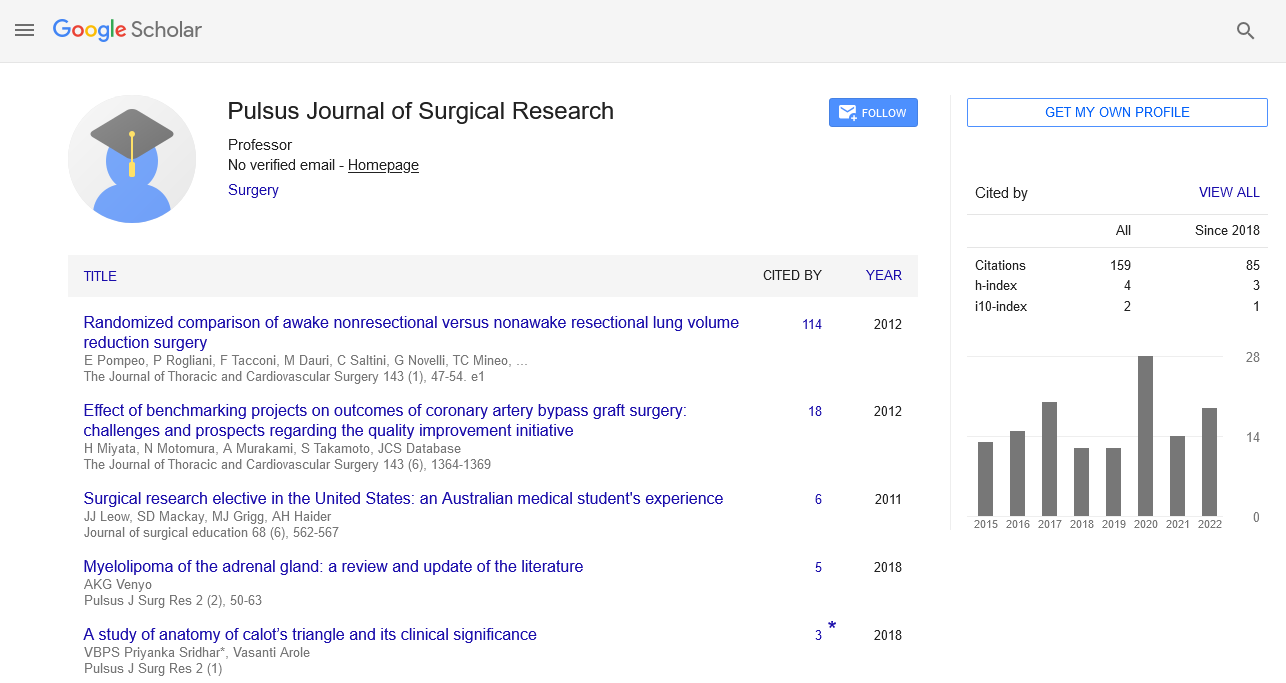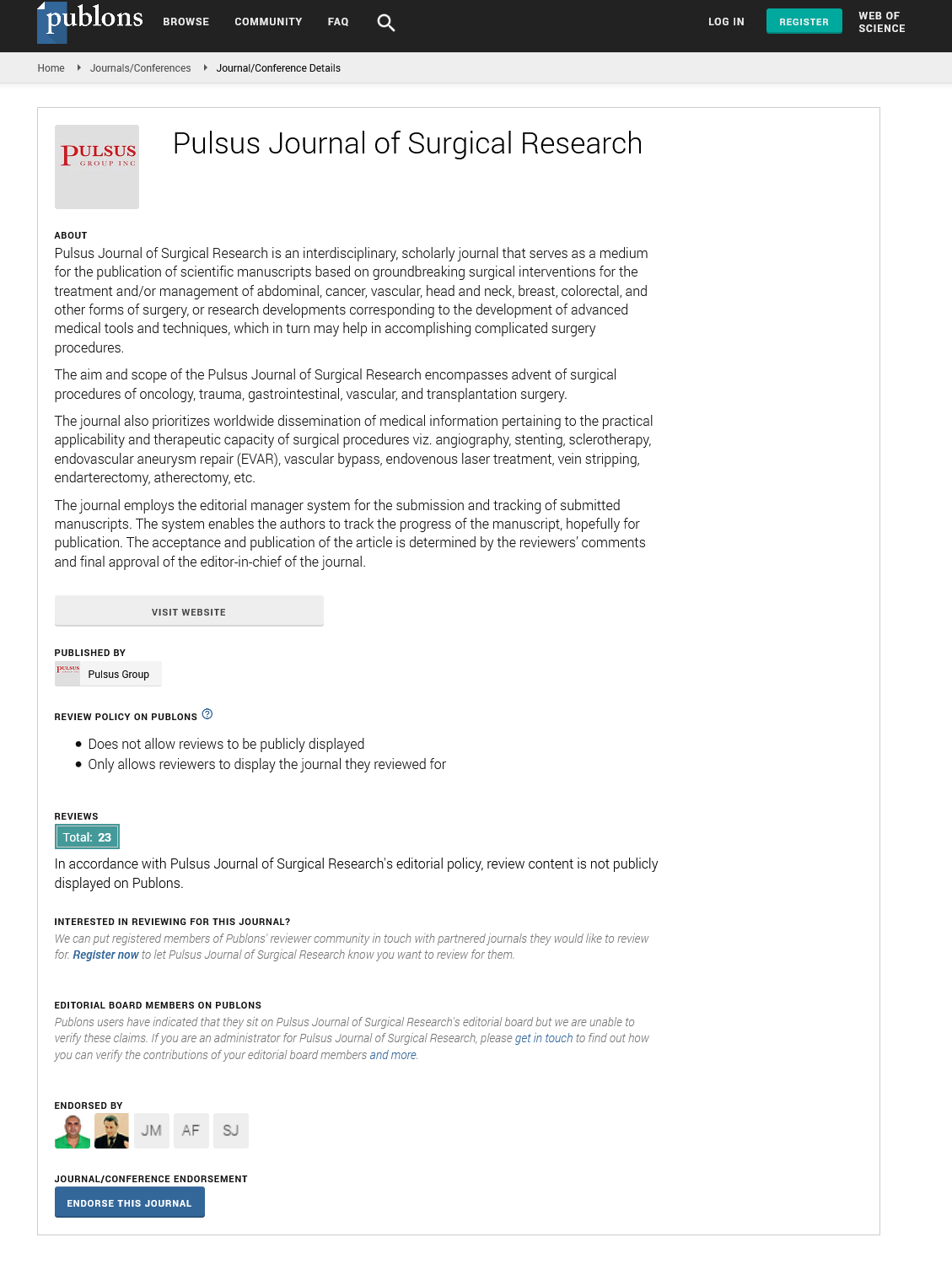
Sign up for email alert when new content gets added: Sign up
VDR gene and bone mass
Webinar on Osteoporosis, Arthritis and Musculoskeletal Disorders
June 15, 2022 | Webinar
Massimo Piracci
Czech Rehabilitation Hospital Al Ain, UAE
ScientificTracks Abstracts: Pulsus J Surg Res
Abstract :
Background: In recent years, the relevance of vitamin D receptor (VDR) gene restriction fragment length polymorphisms and BMI has been investigated by a great number of studies. It has been hypothesized that VDR polymorphisms may influence the bone mass. However, studies investigating the associations between specific VDR polymorphisms and bone mass often show controversial results. We have now performed a systematic review of the literature to analyse the relevance of VDR polymorphisms for bone mass. Materials and Methods: An analysis of studies evaluating the association between vitamin D receptor gene polymorphisms Fok1, Bsm1, Taq1, Apa1, and Cdx2, poly (A) and Bgl1 as well as some haplotype combination has been performed. Data were extracted from PubMed using the key words VDR polymorphism in combination with bone mass. Results: This analysis was performed with the intent of giving an up-to-date overview of all data concerning the relevance of VDR polymorphisms for bone mass. Obviously, at present it is still not possible to make any definitive statements about the importance of the VDR genotype for bone mass. It seems probable that interactions with other factors such as calcium and vitamin D intake, 25(OH)D plasma levels and others gene play a decisive role in BMI occurrence and should not be underestimated. Other risk factors such as obesity, smoking status, alcool and others are also frequently mentioned as being more or less important for BMI depending on the VDR genotype. Conclusion: The determination of the VDR is hardly usable test from the point of view of clinical practice. The association between VDR and bone mass is relatively small overall. To date, however, the role played by the VDR gene polymorphisms on bone mass has not been defined with precision and requires a further confirmation in larger population groups, better characterized and different from ethnic point of view. Probably other and environmental factors involved in determining bone mass have yet to be identify. Recent Publications 1. Immunohistochemical evaluation of vitamin D receptor (VDR) expression in cutaneous melanoma tissues and four VDR gene polymorphisms Francesco La Marra, Giuseppe Stinco, Cinzia Buligan, Giovanni Chiriacò, Diego Serraino, Carla Di Loreto, Sabina CauciCancer Biol Med. 2017 May; 14(2): 162–175. doi: 10.20892/j.issn.2095-3941.2017.0020PMCID: PMC5444928. 2. Vitamin D pathway-related gene polymorphisms and their association with metabolic diseases: A literature review Buthaina E. Alathari, Aji A. Sabta, Chinnappan A. Kalpana, Karani Santhanakrishnan VimaleswaranJ Diabetes Metab Disord. 2020 Dec; 19(2): 1701–1729. Published online 2020 Jun 16. doi: 10.1007/s40200-020-00561-w PMCID: PMC7843833 3. Establishing a genetic link between FTO and VDR gene polymorphisms and obesity in the Emirati population Saad Mahmud Khan, Sarah El Hajj Chehadeh, Mehera Abdulrahman, Wael Osman, Habiba Al Safar BMC Med Genet. 2018; 19: 11. Published online 2018 Jan 17. doi: 10.1186/s12881-018-0522-z PMCID: PMC5773046.
Biography :
Massimo Piracci, is a practicing, board certified consultant Orthopedics and Sports Medicine and brings Italian expertise to Saudi German Hospital Dubai. On successful completion of his MBBS from Roma Tor Vergata, Italy in 1992, he subsequently received his MD in Orthopedic and Traumatology from the same University in 1999. Professor Piracci was trained in Orthopedic Surgery in Roma Saint Eugenio Hospital and in Latina Santa Maria Goretti Hospital. From the year 2003 he was HOD in Orthopedic and Traumatology Department in Roma Clinic Annunziatella where he performed more than 10.000 surgeries. Professor Piracci also maintained a 15- year career as a professional FIGC Series A, football referee, during which he also consulted as an external orthopedic physician for varying professional football teams. He received his PH.D in Health Science and Osteopathy on June 7, 2012 and Masters of Science in Sports Medicine on October 21, 2013 in Miami International University in US. In 2014 Professor Piracci was situated in the UAE at AL Salama Hospital and Universal Hospital, Abu Dhabi. Here he successfully treated the Al Jazeera Football Club, goal keeper with ACL reconstruction. He uses the most advanced technologies and biological implant (PRP, Stamina cells, Ozone Therapy) and mini invasive surgery of hip head. He treats the most of orthopedic pathology for children and adults, the most of minor and major trauma, and sport injury with advanced mini invasive technique.For low back pain he uses the treatment with Ozone therapy that resolve the pain giving back a normal life to the patient. He was the HOD of Orthopedic department in Czech Rehabilitaton Hospital in Al Ain and HOD of Regenerative and Sport Medice in Adam Vital Hospital in Dubai. Consultant Orthopedic Surgeon in Valiant Clinic in Dubai. Speaker last year at 2nd national congress SIMCRI giving own experience for a particular implant of biological screw in osteonecrosis.





